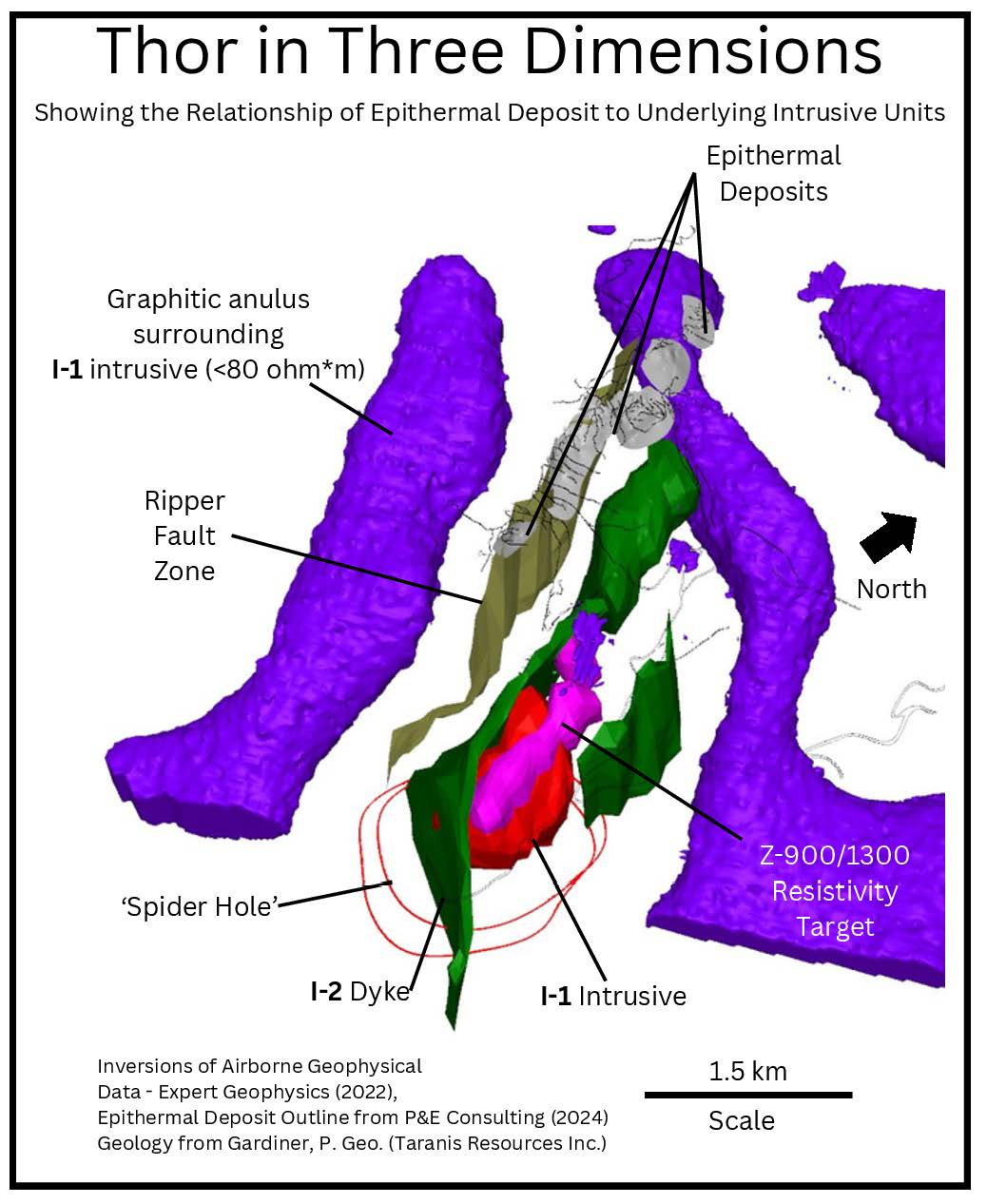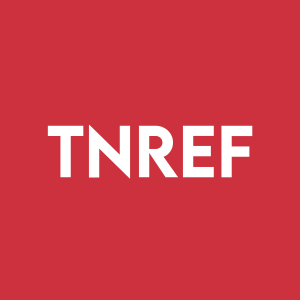Taranis Outlines Alkalic Intrusive System Underlying Thor Epithermal Deposit
Rhea-AI Summary
Taranis Resources (TNREF) has announced significant findings from its 2024 diamond drilling program at the Thor project, revealing two previously undocumented intrusive bodies. The exploration was guided by a 'linked epithermal-porphyry' geological model, marking the first discovery of intrusive rocks in Thor's 130-year history.
The company identified two distinct intrusive events: Intrusive Event #1 (I-1), a 1.2 km diameter circular-shaped igneous body located 2.0 km southeast of the epithermal deposit, and Intrusive Event #2 (I-2), a younger dyke system flanking I-1. I-1 is believed to be the source of precious and base metals in the Thor epithermal deposit, while I-2 is a later formation that has disrupted the epithermal deposit.
The discovery followed a 2022 airborne magnetotelluric/magnetic survey and includes zones of advanced argillic alteration with anomalous gold over substantial widths (+30m). The company is conducting ongoing investigations including geochemistry, age-dating, and TEM mineralogical analyses at the Colorado School of Mines.
Positive
- Discovery of two significant intrusive bodies at Thor, marking first occurrence in 130-year history
- Identification of anomalous gold zones over substantial widths (+30m)
- Confirmation of potential continuation of Thor epithermal deposit down-dip
Negative
- Full evaluation of the Z-900/1300 feature delayed to 2025 due to drilling limitations in 2024
News Market Reaction 1 Alert
On the day this news was published, TNREF gained 9.62%, reflecting a notable positive market reaction.
Data tracked by StockTitan Argus on the day of publication.
Very Exciting Development at Thor!
ESTES PARK, CO / ACCESS Newswire / February 6, 2025 / Taranis Resources Inc. ("Taranis" or the "Company") (TSX.V:TRO)(OTCQB:TNREF) is providing an initial overview of the 2024 diamond drilling program at Thor. Taranis undertook a drilling exploration program at Thor using a ‘linked epithermal-porphyry' geological model, and this approach has resulted in the identification of two intrusive bodies at Thor. The basic premise of this geological model is that epithermal deposits can be underlain by large, mineralized intrusives. This News Release will be the first of several that discuss more detailed exploration results of the 2024 exploration program.
In the +130-year history of exploration and mining at Thor, there have been no documented occurrences of intrusive rocks. The presence of deep, underlying intrusive rocks at Thor became a high-level priority in 2021 after it was recognized that there were large areas of hydrothermal alteration at Thor surrounding the epithermal deposit that had hallmarks of alteration related to something other than the epithermal deposit itself. The host rocks at Thor are Lower Paleozoic metasedimentary-metavolcaniclastic rocks, and alteration has manifested itself quite differently from deposits in British Columbia that are hosted in volcanic rocks.
In May 2022, Expert Geophysics completed an airborne magnetotelluric ("MT")/magnetic survey at Thor and identified a number of geophysical features that indicated the presence of a concealed intrusive. In 2024, the initial drill holes were completed to test some of these features, and a variety of formations were encountered that either have direct connection with an intrusive - or are related to contact alteration around an intrusive. These intrusive-related rocks bear little or no resemblance to the geology mapped at surface and are subject of ongoing investigation including geochemistry, age-dating and Transmission Electron Microscopy ("TEM") mineralogical analyses at the Colorado School of Mines, Golden, Colorado. Taranis has also completed Rare Earth Element and Major Oxide geochemistry on drill cores from 2024 to gain further insight into the large-scale alteration patterns seen in the host rocks.
Two Types of Intrusives at Thor and Relationship to the Epithermal Deposit
The figure that accompanies this News Release shows the spatial relationship between the epithermal deposit at Thor, and some of the underlying alkalic intrusive and intrusive-related rocks. This model is based on surface mapping, diamond drilling (over 250 drill holes), and inverted magnetic and resistivity data from Expert Geophysics. Alkalic rocks are rich in sodium and potassium relative to silica, and are important when differentiating intrusive rocks in British Columbia because this particular type of intrusive is related to some of the largest intrusive-related gold and copper deposits in British Columbia.
Intrusive Event #1
The oldest, and largest igneous event is I-1 ("Igneous Event #1") and is identifiable as a resistive, 1.2 km diameter circular-shaped igneous body ~2.0 km southeast of where the epithermal deposit is located. The top of this intrusive body is located at least 400m below the surface. Immediately overlying this feature is Z-900/1300 that is an elongated resistivity feature that is a contact-related alteration zone that is heavily albitized (
Intrusive Event #2
A younger, second intrusive (I-2) ("Igneous Event #2") forms two dyke-like bodies that flank I-1. This dyke system is enveloped in wide zones of epidote, chlorite and magnetite. I-2 crosscuts the Silver Cup Anticline. The dyke itself is alkalic and mafic in composition, and has high levels of magnesium. The presence of up to
Comment
John Gardiner, President and CEO of Taranis states "Exploration companies talk about finding large, hidden mineral deposits in British Columbia, and unequivocally this approach is going to find British Columbia's next generation of mines. This requires a long-term approach not only being able to identify favorable geology, but the investment of time and capital. The jewel at Thor lies in the ability to find a mineralized intrusive, and we have made significant progress in that direction. Taranis' prescription has involved a systematic approach to targeting, transitioning from shallow to deeper exploration. Taranis has also leveraged modern technology to define and understand these targets, of which some examples include passive electromagnetic surveying, alteration geochemistry, TEM and most of all experience".
About Taranis and Thor
Taranis Resources is a Canadian mineral exploration company. The Thor Project is in southeast British Columbia. Taranis has completed upwards of 250 drill holes, linking all previously known mines into a single, near-surface epithermal deposit that has been recently updated into an NI 43-101 Mineral Resource Estimate (see Taranis News Release dated April 11, 2024). In the summer of 2024, Taranis initiated deep drilling aimed at finding the source of the 2 km long epithermal deposit.
Qualified Person
Exploration activities at Thor were overseen by John Gardiner (P. Geo.), who is a Qualified Person under the meaning of Canadian National Instrument 43-101. John Gardiner is a principal of John J. Gardiner & Associates, LLC which operates in British Columbia under Firm Permit Number 1002256. Mr. Gardiner has reviewed and approved the comments contained within this News Release.
For additional information on Taranis or its
Taranis currently has 100,348,854 shares issued and outstanding (113,827,227 shares on a fully-diluted basis).
TARANIS RESOURCES INC.
Per: John J. Gardiner (P. Geo.), President and CEO
For further information contact:
John J. Gardiner
681 Conifer Lane
Estes Park, Colorado 80517
Phone: (303) 716-5922
Cell: (720) 209-3049
johnjgardiner@earthlink.net
NEITHER THE TSX VENTURE EXCHANGE NOR ITS REGULATION SERVICES PROVIDER (AS THAT TERM IS DEFINED IN THE POLICIES OF THE TSX VENTURE EXCHANGE) ACCEPTS RESPONSIBILITY FOR THE ADEQUACY OR ACCURACY OF THIS NEWS RELEASE.
This News Release may contain forward looking statements based on assumptions and judgments of management regarding future events or results that may prove to be inaccurate as a result of factors beyond its control, and actual results may differ materially from expected results.

SOURCE: Taranis Resources, Inc.
View the original press release on ACCESS Newswire







